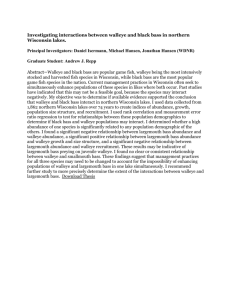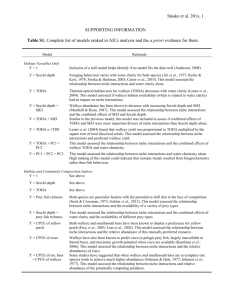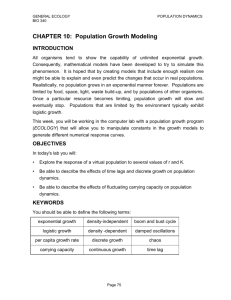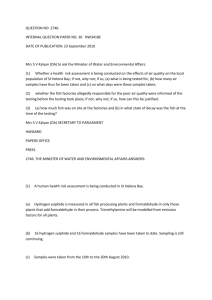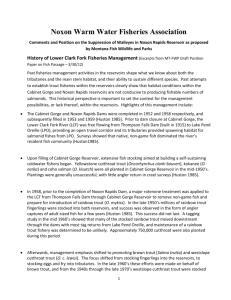2015 Noxon Reservoir Walleye Study Plan In February 2013
advertisement
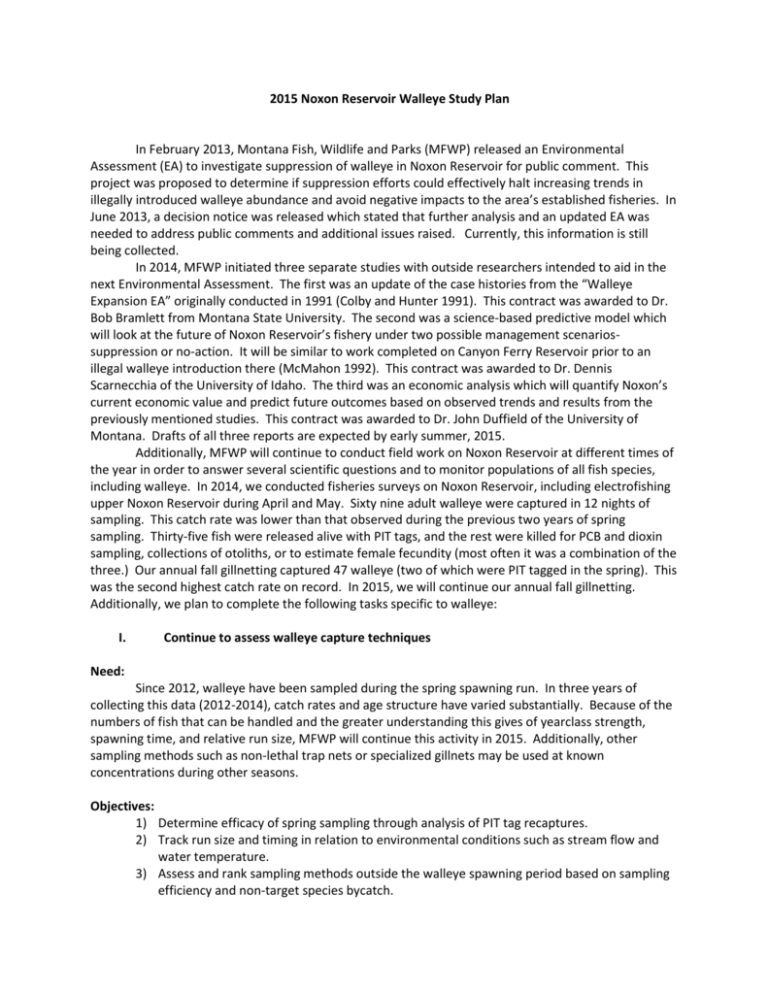
2015 Noxon Reservoir Walleye Study Plan In February 2013, Montana Fish, Wildlife and Parks (MFWP) released an Environmental Assessment (EA) to investigate suppression of walleye in Noxon Reservoir for public comment. This project was proposed to determine if suppression efforts could effectively halt increasing trends in illegally introduced walleye abundance and avoid negative impacts to the area’s established fisheries. In June 2013, a decision notice was released which stated that further analysis and an updated EA was needed to address public comments and additional issues raised. Currently, this information is still being collected. In 2014, MFWP initiated three separate studies with outside researchers intended to aid in the next Environmental Assessment. The first was an update of the case histories from the “Walleye Expansion EA” originally conducted in 1991 (Colby and Hunter 1991). This contract was awarded to Dr. Bob Bramlett from Montana State University. The second was a science-based predictive model which will look at the future of Noxon Reservoir’s fishery under two possible management scenariossuppression or no-action. It will be similar to work completed on Canyon Ferry Reservoir prior to an illegal walleye introduction there (McMahon 1992). This contract was awarded to Dr. Dennis Scarnecchia of the University of Idaho. The third was an economic analysis which will quantify Noxon’s current economic value and predict future outcomes based on observed trends and results from the previously mentioned studies. This contract was awarded to Dr. John Duffield of the University of Montana. Drafts of all three reports are expected by early summer, 2015. Additionally, MFWP will continue to conduct field work on Noxon Reservoir at different times of the year in order to answer several scientific questions and to monitor populations of all fish species, including walleye. In 2014, we conducted fisheries surveys on Noxon Reservoir, including electrofishing upper Noxon Reservoir during April and May. Sixty nine adult walleye were captured in 12 nights of sampling. This catch rate was lower than that observed during the previous two years of spring sampling. Thirty-five fish were released alive with PIT tags, and the rest were killed for PCB and dioxin sampling, collections of otoliths, or to estimate female fecundity (most often it was a combination of the three.) Our annual fall gillnetting captured 47 walleye (two of which were PIT tagged in the spring). This was the second highest catch rate on record. In 2015, we will continue our annual fall gillnetting. Additionally, we plan to complete the following tasks specific to walleye: I. Continue to assess walleye capture techniques Need: Since 2012, walleye have been sampled during the spring spawning run. In three years of collecting this data (2012-2014), catch rates and age structure have varied substantially. Because of the numbers of fish that can be handled and the greater understanding this gives of yearclass strength, spawning time, and relative run size, MFWP will continue this activity in 2015. Additionally, other sampling methods such as non-lethal trap nets or specialized gillnets may be used at known concentrations during other seasons. Objectives: 1) Determine efficacy of spring sampling through analysis of PIT tag recaptures. 2) Track run size and timing in relation to environmental conditions such as stream flow and water temperature. 3) Assess and rank sampling methods outside the walleye spawning period based on sampling efficiency and non-target species bycatch. Methods: Beginning in late-March or early-April, MFWP will night electrofish for walleye in the upper portion of Noxon Reservoir. Effort will consist of two to three nights per week until mid to late May, or as flow conditions permit. Basic biological data will be collected from all fish including length, weight, and sex. Ages will be estimated using either dorsal spines or otoliths. All walleye released alive will receive a PIT tag in the left cheek. Recaptures of PIT tagged fish throughout the spring season will help determine the efficacy of sampling, as well as relative run size. Additionally, PIT tagged fish captured elsewhere throughout the year will be used to assess growth and distribution. Total Clark Fork River discharge and water temperature will be measured and linked to run timing and size. At any point throughout the year, MFWP may also use gill, trap, fyke, seine, trammel, or other nets in areas of known walleye concentrations identified by past telemetry studies or gillnet surveys. Additionally, ¾ inch mesh gill nets may be deployed for two hour durations to test capture efficiency of yearling walleye. Walleye catch rates, bycatch and sampling mortality for non target species will be used to assess capture techniques. II. Identify age and size structure of walleye in Noxon Reservoir Need: This information is essential to characterize the population of walleye in Noxon Reservoir and determine physical conditions that promote age-class recruitment within the population. Current data suggests that water year, that is the discharge in the spring runoff, may be one of the factors driving walleye recruitment. However, to date there does not appear to be a direct linear relationship between spring discharge and yearclass strength. Based on samples obtained in the 2014 fall gillnet series, it appears that 2012 produced a relatively strong cohort despite an above average river discharge in May and June. On the same note, high flows in 2011 appear to have limited recruitment for that cohort. These cohorts will continue to be tracked by evaluating the number of age-3 and age-4 fish captured during spring sampling on the walleye spawning grounds in 2015. We will assess peak discharge, total discharge, and the timing and duration of runoff to determine if a relationship to recruitment is observed. Other studies have recommended a sample size of 200-250 walleye in order to accurately assess biological parameters and determine the status of a population. This does not require lethal sampling of all fish. Objectives: 1) Collect and analyze size data and dorsal spines (for aging) from all captured walleye. 2) Collect otoliths from a subset of walleye to validate nonlethal (dorsal spines) ages. 3) Compare age-class strength to environmental conditions in order to determine what influences walleye recruitment. Methods: All captured walleye will be measured for length and weight prior to release or euthanasia. Aging structures will be collected from each fish. The primary aging structure will be dorsal spines; however, some walleye otoliths will also be collected. Our goal is to obtain 10 otoliths from each sex in each 2 inch size class up to 22” (from spring sampling, this is likely 16-22”). Most otoliths will be extracted from fish already killed for the mercury (Hg) concentration study which aims to collect approximately 60 fish from spring sampling in Noxon Reservoir (see Task IV). These fish (<22”) represent our younger yearclasses and are the basis for yearclass strength assessment and proposed genetics work (Task III). Based on past catch rates, it is possible that between 10 and 30 additional fish will be killed specifically for otolith extraction. Otoliths have been shown to be more accurate and require less time and equipment to read than dorsal spines. Variability in growth observed between years in Noxon Reservoir deems verification by otoliths even more important than originally thought. Accurate ages are necessary to identify cohort strength and for proposed genetic work in 2015 (Task III). III. Estimate effective population size using genetics Need: Total population size of walleye in Noxon Reservoir is unknown, although trend data indicates a generally increasing population. To date, walleye have only been caught in substantial numbers while electrofishing over spawning habitat downstream of Thompson Falls Dam. Currently, technology exists to estimate the number of breeders which produced a known-age cohort of fish (Waples and Do 2008, Waples and Do 2010, Whiteley et al. 2012). Linkage disequilibrium is a method of analysis which looks at common genotypes of offspring in order to determine the number of adults which created them. If an accurate estimate of the breeding population can be made, those results could be compared with electrofishing or netting catch rates in order to determine the potential efficiency of any future programs. Objectives: 1) Collect genetic clips from fifty walleye per known-age cohort in order to estimate the number of breeders which produced that cohort. 2) Determine if sufficient numbers of walleye can be effectively captured during sampling in order to impact that estimated population size. Methods: Walleye collected from known-age cohorts will have genetic clips removed and stored in ethyl alcohol until a sample size of fifty per cohort is collected. It is hoped that 1-2 cohorts of fish may be collected in 2015 from routine sampling. Genetic sampling is non-lethal, but samples may be combined with other lethally sampled fish so that a sub-set of ages can be verified by otoliths. IV. Analyze walleye for mercury (Hg) concentration Need: The reservoirs on the Lower Clark Fork River are a natural “sink” for contaminants, largely mercury (Hg). Analyses from 2010 sampling revealed Hg concentrations in some predatory fish as high as 1.39 ppm, while 2005 analyses found fish as high as 2.39 ppm. Any fish Hg concentration greater than 1.18 ppm is considered unsafe for consumption by women and children. Sampling waterbodies that contain fish with elevated Hg concentrations routinely is important to understand the risks to human health from fish consumption and assess the variability that occurs between sampling events. FWP regularly conducts this sampling in waters across Montana. In 2010, all size groups of walleye analyzed from Noxon Reservoir had much lower Hg concentrations compared to samples from 2005. Differences also exist in the consumption guidelines between Cabinet Gorge and Noxon Reservoirs. The field season of 2015 represents five-years since the last Hg sample events on Noxon and Cabinet Gorge reservoirs. Sampling all available size groups of smallmouth bass, northern pike, walleye, and yellow perch in the spring and fall 2015 would allow us to compare changes in seasonal fish Hg concentrations over a 10-year period. We will also look at differences between reservoirs in an attempt to standardize consumption guidelines across the lower Clark Fork reservoirs. Fall mercury samples will be obtained strictly from fish already killed in monitoring gillnets. Objectives: 1) Collect walleye during spring and fall sampling in order to evaluate current mercury concentrations in Noxon and Cabinet Gorge Reservoirs. Methods: Sample size will depend on capture efficiency, but up to 15 walleye from each 4-inch size group would be collected from each reservoir. For walleye, size categories used in consumption advisories are: 10-14”, 14-18”, 18-22”, 22-26”, and 26+”. Additionally, depending on funding, up to five of the large size class (26”+) may also be tested for PCBs, dioxins, and/or furans. Efforts in 2014 failed to capture a sufficient sample from this larger size class. This testing requires lethal sampling. V. Assess reproductive potential of Noxon Reservoir female walleye. Need: Walleye fecundity is high compared to other species in Montana. Large female walleye have been documented with over 600,000 eggs. A more general rule is a female walleye will produce about 25,000 eggs per pound of body weight. The reproductive potential of walleye in Noxon Reservoir was questioned several times during the public comment period for the Draft Environmental Assessment to Investigate Suppression of Walleye in Noxon Rapids Reservoir. In 2014, the mean fecundity of Noxon walleye was similar to this range-wide average (~27,000 eggs per pound). FWP will continue to investigate egg production in female walleye in Noxon Reservoir. Objectives: 1) Collect eggs from female gravid walleye in Noxon Reservoir to assess walleye fecundity. Methods: All female walleye which are being sacrificed for other purposes will have their eggs collected for fecundity estimates. No walleye will be sacrificed specifically for this study in 2015. VI. Assess angler exploitation of walleye within Noxon Reservoir Need: Numerous comments collected during the public comment period suggested that anglers alone were capable of suppressing the walleye population. Angler exploitation has not been sufficient to control invasive populations of walleye in other waters, however high levels of exploitation may contribute to suppression efforts. Montana Fish, Wildlife and Parks is planning a creel survey for 2015 which will assist in determining angler harvest of walleye. Objectives: 1) Determine angling pressure and preferences during open water season in Noxon and Cabinet Gorge Reservoirs. 2) Estimate angler exploitation based on creel interviews and instantaneous counts (aerial flights). Methods: Beginning in spring, 2015, MFWP will conduct an access point creel survey on Noxon and Cabinet Gorge Reservoirs. Interviews will be conducted based on a stratified random sampling scheme which will adjust for more heavily pressured locations, seasons, and times of day. Additionally, aerial flights will be used to quantify total instantaneous effort throughout the sample period in order to calculate pressure and harvest. All walleye encountered will be scanned for the presence of a PIT tag. Recaptures of PIT tagged fish may provide additional information on harvest levels in proportion to overall population size. Contact: Ryan Kreiner, FWP Fisheries Biologist, Thompson Falls Area Office, 406-827-9320, rkreiner@mt.gov References Colby, P., and C. Hunter. 1989. Environmental assessment of the introduction of walleye beyond their current range in Montana. Montana Department of Fish, Wildlife, and Parks, Helena. McMahon, T. 1992. Potential Impacts of The Introduction Of Walleye To The Fishery Of Canyon Ferry Reservoir And Adjacent Waters. Montana Department of Fish, Wildlife, and Parks, Helena. Waples, R.S., and C. Do. 2008. LDNE: a program for estimating effective population size from data on linkage disequilibrium. Molecular Ecology Resources 8: 753-756. Waples, R.S., and C. Do. 2010. Linkage disequilibrium estimates of contemporary Ne using highly variable genetic markers: a largely untapped resource for applied conservation and evolution. Evolutionary Applications 3: 244-262. Whiteley, A.R., J.A. Coombs, M. Hudy, Z. Robinson, K.H. Nislow, and B.H. Letcher. 2012. Sampling strategies for estimating brook trout effective population size. Conservation Genetics. 13:625-637.

